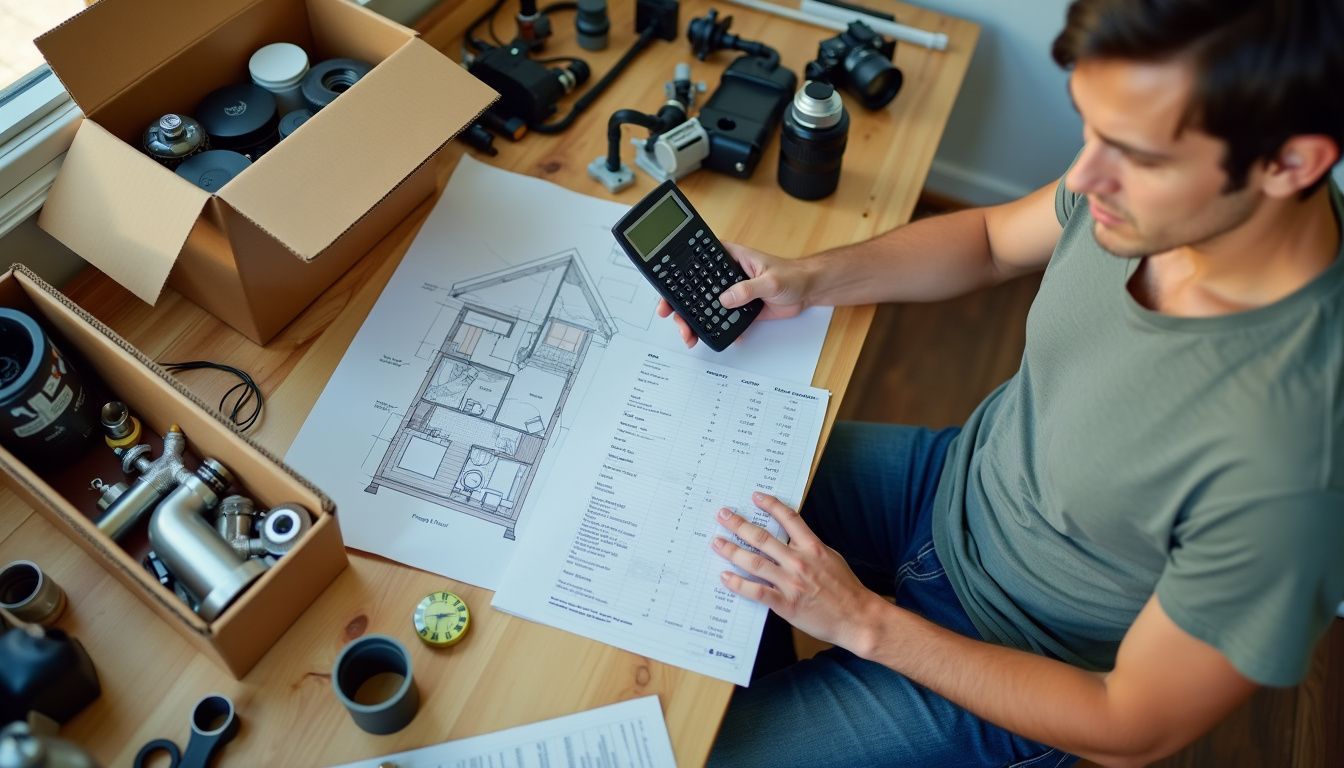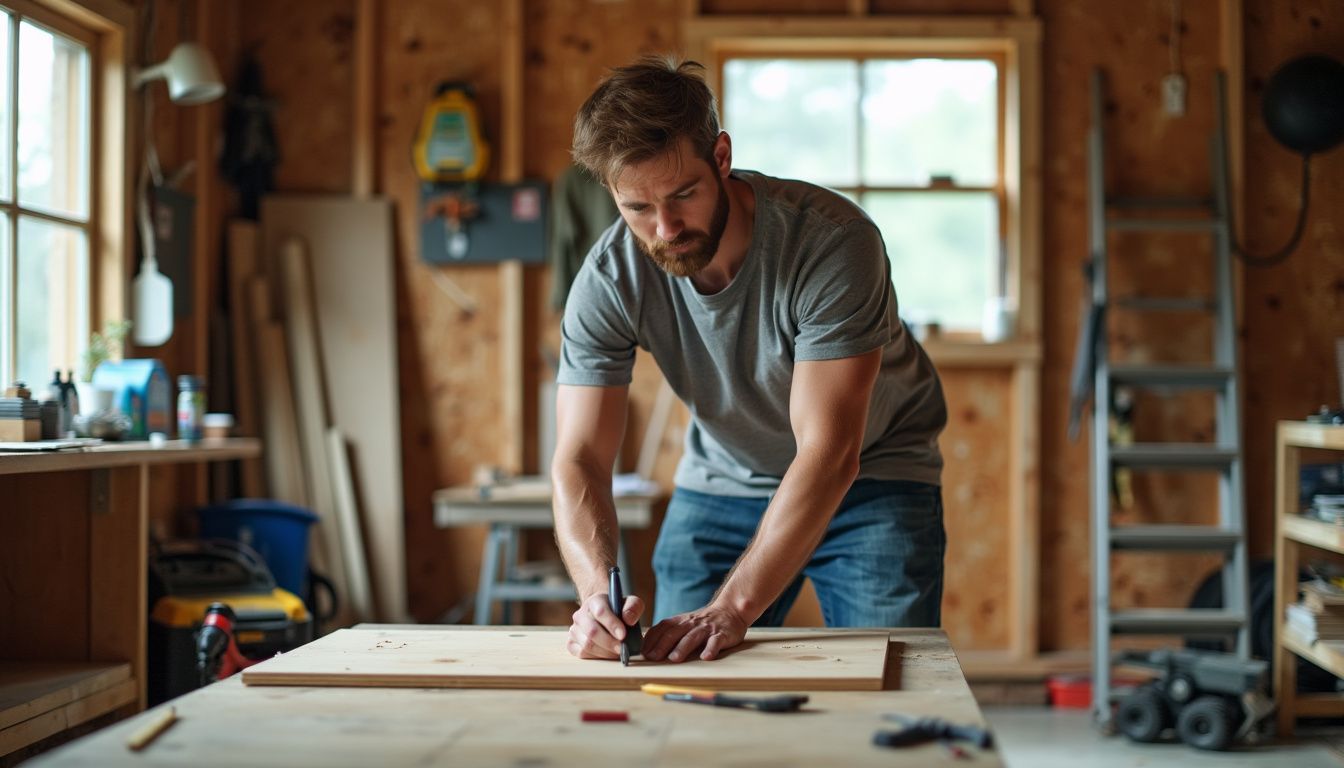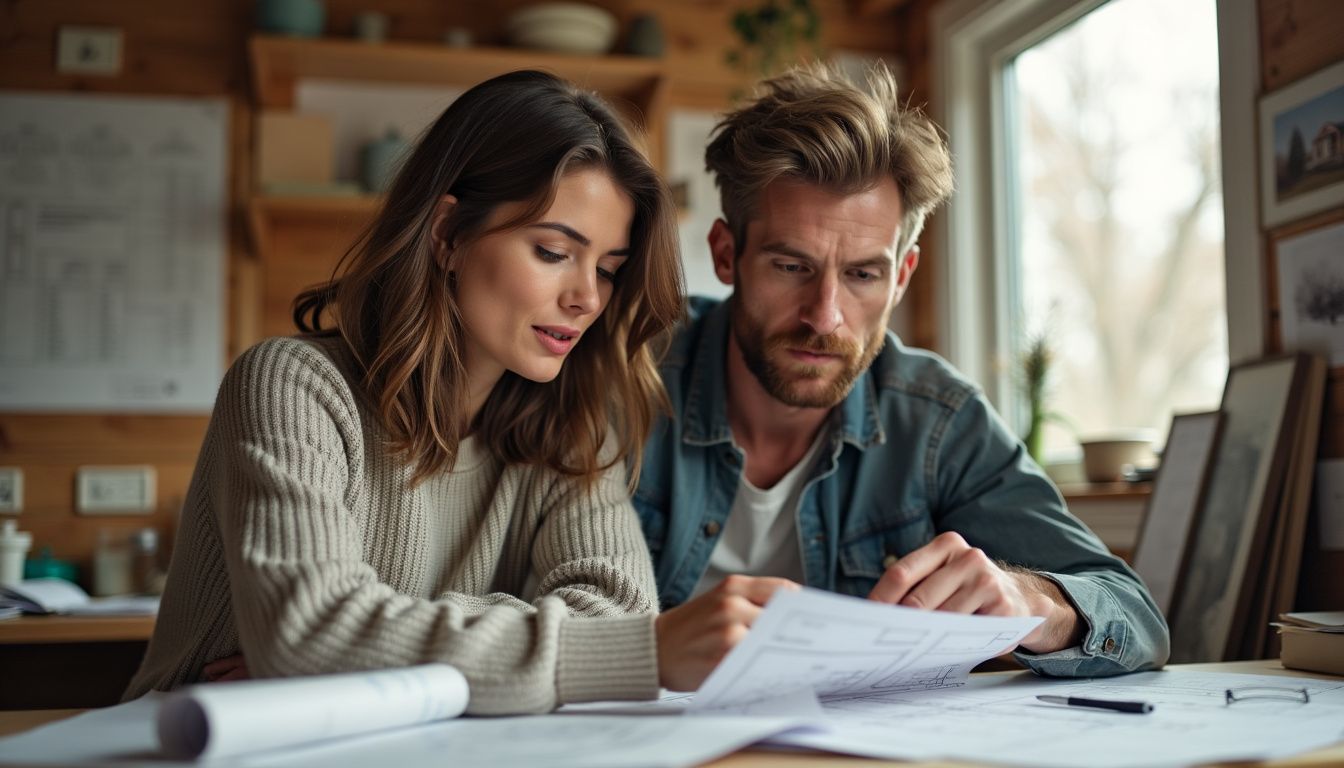Last updated on August 8th, 2025 at 08:19 pm
Are you wondering about the cost to build a tiny house? The average price is about $50,000. We will guide you through understanding these costs better. Looking to Build a Tiny House? Find Out the Average Cost.
A Guide to Tiny House Building Costs
Key Cost Factors
Building Permits
Land (per acre)
Materials
Labor
Types of Tiny Houses
🚚 Tiny House on Wheels (THOW)
• Trailer included
• Most popular choice
🏕️ Park Model RV (PMRV)
• RV park compatible
• 1 bed, 1 bath
🏗️ Tiny House on Foundation
• Higher resale value
• Easier insurance
Additional Costs to Consider
⚠️ Don’t Forget These Expenses!
💡 Money-Saving Tips
Building Permits and Taxes
Getting a permit for your tiny home can cost from a few hundred to some thousand dollars. This step is key if you want your house to follow local rules. If you choose to put your tiny house on a permanent base, you will also need to pay property taxes.
Land Acquisition
Buying land is a big step in making a tiny house. The price for land can change a lot depending on where you want to live. For example, an acre might cost about $2,000 in Alabama. But if you move up to New Jersey or New York, that same acre could be around $13,000.
Across the whole U.S., the average price per acre sits at roughly $16,182.
You also need to think about homeowners associations (HOAs) and local rules. Some places have strict rules about what kind of house you can build. This means even after buying your spot of land, there might be extra steps before starting construction.
Materials and Labor
Materials for a non-prefab tiny house take up 30% to 50% of the total cost. This means if you’re spending $14,000 or more, a big chunk of that goes into things like wood, windows, and roofing.
Electricians and plumbers charge $45 to $200 per hour. These pros make sure your tiny house is safe and works right.
Next, let’s think about how the size and design affect your budget.
Size and Design Complexity
Bigger tiny homes and fancy designs cost more. Think about it. A small place with basic features might be cheap. But if you want a home that’s 600 sq ft or has luxury touches, expect to pay up to $100,000 or even more for custom work.
The price jumps based on how complex your design is. If you dream of unique styles or high-end finishes, like top-notch kitchen cabinets or solar panels for off-grid power, the bill goes up.
Choosing special materials can also raise the price. For example, energy-efficient windows and insulation better than fiberglass batts make your tiny house comfy but add to the cost.
Types of Tiny Houses and Their Costs

Tiny House on Wheels (THOW)
A Tiny House on Wheels (THOW) is a small home built on a trailer. It can move from place to place. Many people like THOWs because they offer freedom and flexibility. You don’t need land to put one down, unlike houses that stay in one spot.
Building one costs between $60,000 and $80,000 on average. The trailer itself will set you back about $5,000 to $9,500.
Tiny houses are part of a big movement today. About 73% of Americans say they would think about living in one. This interest helps the housing market for tiny homes grow fast. People look into mortgages or personal loans to help pay for their THOWs.
They also check out things like utilities and how efficient their tiny home can be with space and energy use.
Park Model Recreational Vehicle (PMRV)
Moving from tiny houses on wheels, we see another popular choice: Park Model Recreational Vehicles (PMRVs). These homes are like tiny houses but made for campgrounds or RV parks. They stick to the ANSI RV code, making them a bit different from regular tiny homes.
A PMRV has about 400 square feet of space. Inside, you’ll find one bedroom and one bathroom. Some also have a loft for extra room.
People choose PMRVs for their size and features. They’re small enough to fit in many places but offer enough room to live comfortably. The design often includes large windows, wooden siding, and sometimes porches or decks.
With these models, you get the experience of tiny house living with some perks of traditional camping.
Tiny House on a Foundation (THOF)
Switching gears from Park Model Recreational Vehicles, we find ourselves looking at Tiny Houses on a Foundation (THOF). This type of tiny house sits on a permanent base and often feels more like a traditional home.
The costs to set this foundation can range between $53,000 to $57,000. For the foundation alone, expect to pay around $5.50 to $8 for every square foot.
The total cost for building one of these homes can vary widely—from as low as $35,000 to upwards of $68,000 or more. Factors such as materials used, square footage, and how complex the design is play big roles in the final price tag.
These homes offer stability and may have a higher resale value compared to their mobile counterparts due to being attached firmly to land. They also might qualify easier for homeowners insurance since they’re seen as less risky by insurers.
Additional Costs to Consider

When you build a tiny house, think about more than just the walls and roof. There are things like setting up water and power or adding cool gadgets inside that add to your budget.
Utility Hook-Ups and Solar Panels
Hooking up a tiny house to power and water can cost differently based on where you are. If you’re pulling electricity from an existing line, it might only set you back a few hundred dollars.
But if your tiny home is far out in the countryside, setting up electrical lines could go over $5,000. For city sewer hookups, the price swings widely too – from $500 to a staggering $20,000.
Solar panels offer another way to power your home. They can slash your electric bills in the long run. Installing them will cost between $5,000 and $15,000. This makes solar energy an attractive option for many looking to live off-grid or reduce their impact on the planet.
Next up, let’s talk about what goes inside your tiny house – interior fixtures and appliances.
Interior Fixtures and Appliances
In planning your petite residence, consider necessities like basins, illumination, and ventilation systems. These may range from $800 to $4,000 in price. Further expenditure might include appliances such as refrigerators and cooking stoves, potentially adding another $1,000 to $4,000 to your financial planning.
The wise selection of brands for these items can significantly influence your total expenditure.
A variety of temperature control options are available, including compact air conditioning units and electric heating solutions that maintain a pleasant atmosphere in your space. Opting for energy-efficient models can lead to long-term cost savings.
In terms of water heating, tankless systems are a sensible selection due to their lower energy consumption.
Transportation and Setup (for mobile tiny houses)
Moving a mobile tiny home needs a big vehicle. The right truck or van is key because trailers cost $5,000 to $9,500. Before the move, make sure your vehicle can tow your tiny house safely.
Once you get to where you’re going, setting up can begin.
Renting space for your tiny house on wheels might be between $250 and $1,500 every month. Think about this cost as you plan where to live. Hooking up utilities comes next after parking it.
This step makes your tiny house ready to live in.
Potential Savings

Building your own tiny house can cut costs, especially if you’re good with tools. Choosing a ready-made kit over a unique design also saves money.
DIY vs. Professional Building
Deciding between DIY and hiring pros to build a tiny home is big. DIY means doing it yourself. Pros are people you hire. Both choices affect cost a lot. Here’s a simple look at both.
| Aspect | DIY Building | Professional Building |
|---|---|---|
| Cost | Can be as low as $10,000 for homes under 100 square feet | More costly, labor is about 50% of the price |
| Skills Needed | You need to learn a lot. Great for hands-on people. | No need. Pros have the skills. |
| Time Spent | Takes a lot of your time. | Pros work faster because they know how. |
| Control | You make all the choices. You control the look and feel. | You have some control, but pros make a lot of decisions. |
| Quality | It can vary. Depends on your skill. | Usually high. Pros know their stuff. |
DIY can save you a lot of money. For small homes, it can cost less than $25,000. You cut out labor costs which are half the builder’s price. But, you need to know or learn a lot. It also takes much more of your time.
Hiring pros costs more. Yet, they build fast and well. You get less stress but less control too. You pay for their skills.
Both ways have their own benefits. The choice depends on your budget, time, and skills.
Prefabricated Kits vs. Custom Builds
Moving from the choice between doing it yourself or hiring professionals, let’s talk about another big decision: choosing between prefabricated kits and custom builds for your tiny house. This choice affects both your budget and the final look of your tiny home.
| Aspect | Prefabricated Kits | Custom Builds |
|---|---|---|
| Cost | Usually cheaper, with basic cabin kits ranging from $6,000 to $8,000. | Can climb to $100,000 or more, especially with unique features. |
| Time | Faster to assemble since parts are pre-made. | Takes longer since everything is built from scratch to meet specific demands. |
| Design | Less freedom. Designs are standard. | Full control over how the tiny house looks and functions. |
| Material Quality | Varies, but generally good. Depends on the kit provider. | Entirely up to you. You choose everything, so it can be very high. |
| Personal Touch | Limited. Adjustments and customizations are minimal. | Unlimited. Every detail reflects your choice and style. |
Choosing between a kit and a custom build involves weighing these factors. Do you value saving money and time? Then a prefabricated kit might be your best bet. Or do you dream of a tiny house that perfectly matches your vision, down to the last detail? If so, going for a custom build could be the right path. Each has its benefits and challenges, but the choice ultimately depends on what matters most to you.

Financing a Tiny House
Paying for a tiny house can be tricky. Some people use savings, but banks and credit unions offer loans too.
Mortgage Options and Challenges
Getting a mortgage for a tiny house can be hard. Most lenders don’t like to give loans for homes less than $50,000. This makes buying your small dream home tough. You have to look hard for banks or credit unions that might help.
Some folks go for personal loans instead because they’re easier to get.
New American Funding is one option that stands out. They need you to pay at least 3% down and have a credit score of 620 or more. This shows there are ways to finance your tiny house, but it takes work and the right numbers on your side.
Grants and Alternative Funding Sources
Financing a tiny house can be hard. Money for land and building adds up fast. Here are ways to find grants and other money sources that help:
- Look into federal housing grants. These grants help people build homes without needing to pay the money back. You might find one that fits tiny houses.
- State and local government programs often have money too. They help people in their area build homes, including tiny ones.
- Some non-profits focus on affordable housing. They might offer help or even free services to get your tiny house built.
- Crowdfunding websites let you raise money from others who like your project. This could be friends or people all over the world.
- Home improvement stores sometimes offer discounts or donations of materials to help out.
- Credit unions and local banks might give loans with lower interest rates for small homes. Check with them about options.
- Companies that sell tiny house kits may have financing plans to make buying easier.
- If you own a home, a home equity loan could give you the cash needed for your tiny house project.
- Energy-efficient loans reward you for planning a green home with solar panels or other energy savers.
10.Find companies that optimize design-build processes for quality solutions at lower costs.
These options can turn the dream of owning a tiny house into something real without breaking your budget.
Maintenance and Upkeep Costs
Owning a tiny house means keeping up with repairs and updates. Things like fixing a leaky roof or upgrading your cooling system can add to your costs over time.
Routine Maintenance
Keeping your tiny house in good shape means paying attention to several things. You should service heating and cooling systems every year. This makes sure they work well and keeps your energy bills low.
Also, look around windows and doors for drafts that let air in or out. Sealing these spots helps keep the temperature inside just right.
Taking care of appliances is also key. Make sure things like stoves, plumbing, and water heaters are running smoothly. This prevents big problems later on. Simple steps like these can save you money and trouble over time.
Upgrades and Renovations
After taking care of regular maintenance, some tiny house owners decide to add upgrades or make renovations. Adding solar panels is a popular choice. It costs between $5,000 and $15,000 but can save up to $750 each year on electric bills.
Sometimes, people buy kits to build their tiny houses but find parts are missing. They might spend an extra $5,000 to $15,000 to get everything they need. These changes can help make a tiny home more comfortable and energy-efficient.
Bottom Line
Constructing a compact home typically incurs approximately $50,000. This expenditure is substantially lower than that of a standard residence. The costs may rise to $100,000 for specialized blueprints.
Factors such as land ownership and tax obligations may increase the total expenditure. Overall, opting for a smaller scale can result in financial savings without compromising on a comfortable living area.
Have a house that needs a lot of work or repairs, we buy houses in Fort Worth, TX.
